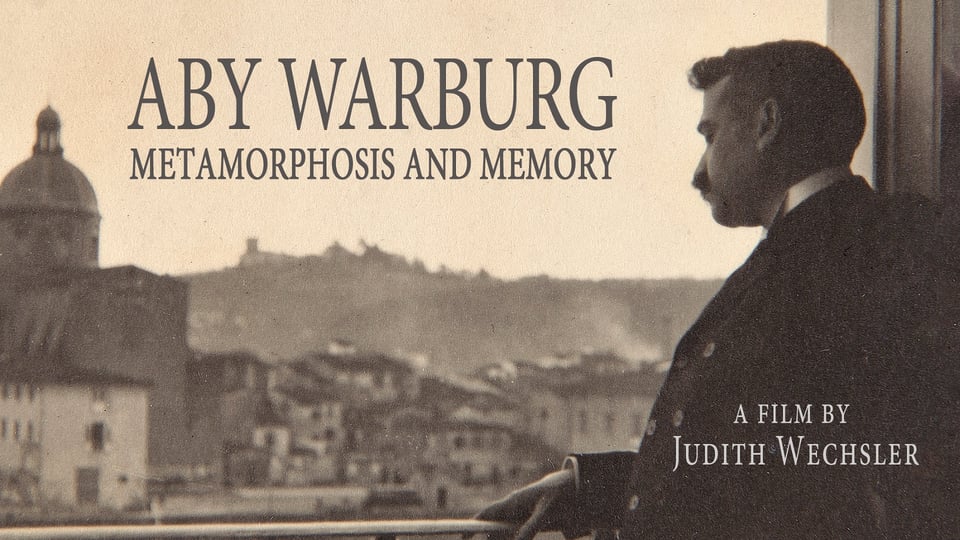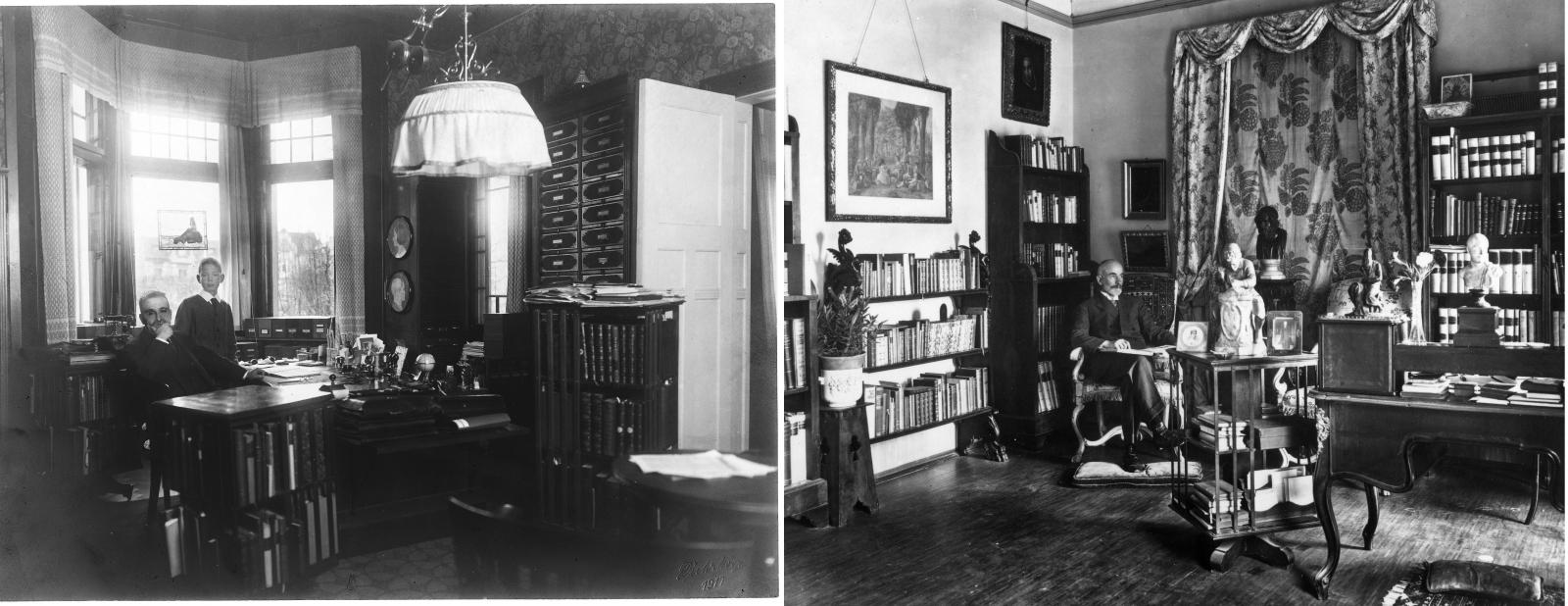
Photo with at least 93 countable boxes visible...

Photo with at least 93 countable boxes visible...
“The library, panels and boxes formed the ensemble of supports on which Aby Warburg’s spiritual work and intellectual creativity were based.” - Benjamin Steiner, Aby Warburgs Zettelkasten Nr. 2 “Geschichtsauffassung”, In: Heike Gfrereis / Ellen Strittmatter (Hrsg.): Zettelkästen. Maschinen der Phantasie (Marbacher Kataloge, 66). Marbach 2013, S. 154-161.
Aby Warburg used three primary tools for his research: his library, a card index, and panels.
His panels would be versions of pinboards, chalk boards, dry erase boards, or online versions of things like Canvas in Obsidian. It amounts to the ability to take notes or images on cards and shuffle them around on a table (or affixed to a wall).
Steiner, Benjamin. “Aby Warburgs Zettelkasten Nr. 2 ‘Geschichtsauffassung.’” In Zettelkästen. Maschinen der Phantasie, edited by Heike Gfrereis and Ellen Strittmatter, 154–61. Marbacher Kataloge 66. Marbach am Neckar, 2013. https://www.academia.edu/8637204/Aby_Warburgs_Zettelkasten_Nr_2_Geschichtsauffassung_.
Methodenstreit mischten sich zahlreichenamhafte Historiker und andere Geisteswissenschaftlerein. Warburg leistete keinen direkten publizistischen Bei-trag, nahm jedoch, wie der Zettelkasten belegt, als passi-ver Beobachter intensiv an der Debatte teil.359
Karl Lamprecht was one of Warburg's first teachers in Bonn and Warburg had a section in his zettelkasten dedicated to him. While Warburg wasn't part of the broader public debate on Lamprecht's Methodenstreit (methodological dispute), his notes indicate that he took an active stance on thinking about it.
Consult footnote for more:
59 Vgl. Roger Chickering, »The Lamprecht Controversy«, in: Historiker- kontroversen, hrsg. von Hartmut Lehmann, Göttingen 20 0 0, S. 15 – 29
Ernst Bernheim,
Aby Warburg's (1866-1929) zettelkasten had references to Ernst Bernheim (1850-1942). Likelihood of his having read Lehrbuch der historischen Methode (1889) as potential inspiration for his own zettelkasten?
When did Warburg start his zettelkasten?
According to Wikipedia, Warburg began his study of art history, history and archaeology in Bonn in 1886. He finished his thesis in 1892, so he may have had access to Bernheim's work on historical method. I'll note that Bernheim taught history at the University of Göttingen and at the University of Bonn after 1875, so they may have overlapped and even known each other. We'll need more direct evidence to establish this connection and a specific passing of zettelkasten tradition, though it may well have been in the "air" at that time.
He even coined a phrase: Verknüpfungszwang - the compulsion to seek connections.
original source?
The searchable digital archive for Aby Warburg's zettelkasten at The Warburg Institute: https://wi-calm.sas.ac.uk/CalmView/Default.aspx
Collection of Index Card Boxes (Zettelkästen) Aby Warburg’s collection of index cards (III.2.1.ZK), containing notes, bibliographical references, printed material and letters, was compiled throughout the scholar’s life. Ninety-six boxes survive, each containing between 200 and 800 individually numbered index cards. Cardboard dividers and envelopes group these index cards into thematic sections. The online catalogue reproduces the structure of the dividers and sub-dividers with their original titles in German and consists of about 3,200 items. Since the titles are transcribed (and not translated into English) you can only search for words in the original German.
Aby Warburg's extant zettelkasten at the Warburg Institute's Archive consists of ninety-six surviving boxes which contain between 200-800 individually numbered index cards. Dividers and envelopes are used within the boxes to separate the cards into thematic sections.
The digitized version is transcribed in the original German and is not available translated into English (at least as of 2023). The digitized version maintains the structure of the dividers and consists of only about 3,200 items.
A full catalogue of Aby Warburg's correspondence, the Institute's correspondence up to 1933 and Warburg's index card boxes is available online through the Warburg Institute Archive online database.
A full catalog of Aby Warburg's 104 index card boxes (reference: WIA III.2.1.ZK) are available online by way of The Warburg Institute's online database at http://wi-calm.sas.ac.uk/calmview/. They are catalogued at the file level.
via https://warburg.sas.ac.uk/archive/archive-online-catalogues
Aby Warburg: Metamorphosis and Memory. Documentary, Biography, 2016. https://www.kanopy.com/en/lapl/video/5913764.
Written, Directed and Produced by Judith Wechsler<br /> Wechsler2016

13:14 - [Aby] Telegram and telephone destroy the cosmos.13:18 Mythical and symbolic thinking13:20 strives to form spiritual bonds13:22 between humanity and the surrounding world,13:25 shaping distance into the space13:27 required for devotion and reflection,13:31 the distance undone13:32 by the instantaneous electrical connection.
Telegram and telephone destroy the cosmos. Mythical and symbolic thinking strives to form spiritual bonds between humanity and the surrounding world, shaping distance into the space required for devotion and reflection, the distance undone by the instantaneous electrical connection. —Aby Warburg, [00:13:14] quoted in Aby Warburg: Metamorphosis and Memory (Original quote??)
57:17 I mean, when we think of the ways57:20 in which ISIS is not only using images for propaganda,57:25 to see a statue,57:28 both of historic worth and of aesthetic value57:32 being so destroyed,57:33 gives you a kind of visceral shock because you feel,57:37 not only the assault on our cultural heritage,57:39 but you feel the assault on the body.
Aby Warburg's views on art history and memory may have a lot to say with respect to our cultural movement of destroying and removing Civil War Monuments which glorify the "Lost Cause" of the South in the United States.
Aby Warburg died of a heart attack52:41 on the 26th of October, 1929,52:45 at the age of 63.
Aby Warburg, scion of a major banking family died on October 26, 1929, just two days before Black Monday on October 28, the stock market crash which marked the end of the "Roaring Twenties" and the beginning of the Great Depression.
Could family influences or changes at that time have caused small, but underlying issues relating to the crash at that time? What was the reaction of the Warburg family on early Monday the 28th?
Aby, as the oldest, would have inherited the bank, but by arrangement with his younger brother in their youth apparently gave it to his brother in exchange for books.
51:20 - [Aby] Not until art history can show51:22 that it sees the work of art51:23 in a few more dimensions than it has done so far51:27 will our activity again attract the interest of scholars51:31 and of the general public.51:36 Every serious scholar51:37 who has to venture on a problem of cultural history51:40 reads over the entrance to his workshop Goethe's lines:51:43 "What you call the spirit of the age51:46 "is really no more51:47 "than the spirit of the worthy historian51:49 "in which the age is reflected."51:57 In my role as psycho-historian,51:59 I tried to diagnose52:00 the schizophrenia of Western civilization52:02 from its images in an autobiographical reflex.52:10 May the history of art and the study of religion,52:13 between which lies nothing at present52:15 but wasteland overgrown with verbiage,52:18 meet together one day in learned and lucid minds,52:22 and may they share a workbench in the laboratory52:24 of the iconological science of civilization.
09:36 - From his early youth, he loved to collect stamps,09:42 and he said if all the images which are around us09:47 would have been lost,09:47 an album of stamps would help us to understand the world.
Just as Warburg's suggestion that an album of collected stamps could help us to understand the world visually if all other images were lost, perhaps subsections of traces of other cultures could do the same.
06:57 The entire range of emotional stirrings,06:59 aggression, defense, sacrifice, mourning,07:03 melancholia, ecstasy, triumph, et cetera, is expressed07:06 through the revival of movements, gestures, and postures,07:11 that is pathosformel:07:12 the expressive formulas of emotion07:15 either taken from ancient modes07:16 or reappearing as mnemonic traces in successive works.
The entire range of emotional stirrings, aggression, defense, sacrifice, mourning, melancholia, ecstasy, triumph, et cetera, is expressed through the revival of movements, gestures, and postures, that is pathosformel: the expressive formulas of emotion either taken from ancient modes or reappearing as mnemonic traces in successive works.
Original source for this? (Likely in German as original.)
Warburg is talking about the expression of current art through the lens of the classical arts and there is a throughline of "mnemonic traces" through out time.
I just watched the documentary Aby Warburg: Metamorphosis and Memory (Wechsler, 2016) via Kanopy (for free using my local library's gateway) and thought that others here interested in the ideas of memory in culture, history, and art history may appreciate it. While a broad biography of a seminal figure in the development of art history in the early 20th century, there are some interesting bits relating to art and memory as well as a mention of Frances A. Yates whose research on memory was influenced by Warburg's library.
Also of "note" is the fact that Aby Warburg had a significant zettelkasten-based note taking practice and portions of his collection (both written as well as images) are featured within the hour long documentary.
Researchers interested in images, art, dance, and gesture as they relate to memory may appreciate this short film as an entrance into some of Aby Warburg's more specialized research which includes some cultural anthropology research into American Hopi indigenous peoples. cc: @LynneKelly
Emily J. LevineAby Warburg and Weimar Jewish Culture:Navigating Normative Narratives,Counternarratives, and Historical Context
Levine, Emily J. “Aby Warburg and Weimar Jewish Culture: Navigating Normative Narratives, Counternarratives, and Historical Context.” In The German-Jewish Experience Revisited, edited by Steven E. Aschheim and Vivian Liska, 1st ed., 117–34. Perspectives on Jewish Texts and Contexts 3. De Gruyter, 2015. https://www.jstor.org/stable/j.ctvbkjwr1.10.
For some scholars, it is critical thatthis new Warburg obsessively kept tabs on antisemitic incidents on the Easternfront, scribbling down aphorisms and thoughts on scraps of paper and storingthem in Zettelkasten that are now searchable.
Apparently Aby Warburg "obsessively kept" notes on antisemitic incidents on the Eastern front in his zettelkasten.
This piece looks at Warburg's Jewish identity as supported or not by the contents of his zettelkasten, thus placing it in the use of zettelkasten or card index as autobiography.
Might one's notes reflect who they were as a means of creating both their identity while alive as well as revealing it once they've passed on? Might the use of historical method provide its own historical method to be taken up on a meta basis after one's death?
Zettelkasten for studying art?
Sometimes having examples of others' work can be helpful. In your case, perhaps perusing some zettelkasten work by previous users within the art/image space? In this respect some of the work by Aby Warburg may be interesting to you. I might suggest starting with his archive here: https://warburg.sas.ac.uk/archive/archive-collections/verknüpfungszwang-exhibition/mnemosyne-materials
Reading room at the Warburg Institute, via Elizabeth Sears.
Is this part of Aby Warburg's zettelkasten?
Aby Warburg and his son Max Adolph in Warburg's study in Hamburg, 1917. © Warburg Institute, London.
http://www.engramma.it/eOS/index.php?id_articolo=3986
Appears to be a row of slip boxes behind Aby Warburg in this photo of his study in Hamburg from 1917.

Knowing about Aby Warburg's zettelkasten use, I'd noticed that the Mnemosyne Atlas looked suspiciously like a visual version of a zettelkasten, but with images instead of index cards or slips. Apparently I'm not the first...
https://warburg.library.cornell.edu/about/mnemosyne-themes
Looking at the broad themes here makes me wonder if they line up potentially with the larger groups of cards in Warburg's zettelkasten?
While the non-discursive, frequently digressive character of the Atlas frustrates any smooth critical narrative of its themes and contents, nine thematic sequences may still be discerned:
The ideas of non-discursive, digressive, and frustrated narrative could easily be applied to a stranger approaching another person's collection of notes.
<small><cite class='h-cite via'>ᔥ <span class='p-author h-card'>Anne Ganzert</span> in (1) Anne Ganzert on Twitter: "@ChrisAldrich @gipperfish @jdconnor @vaultofculture This is early 17th century right? Nice! I always considered Aby Warburg my favorite „early adopter“ but this sounds great. One clear Warburg benefit: the Mnemosyne Atlas is still around and even digitized 👏🏻" / Twitter (<time class='dt-published'>01/16/2022 12:54:03</time>)</cite></small>